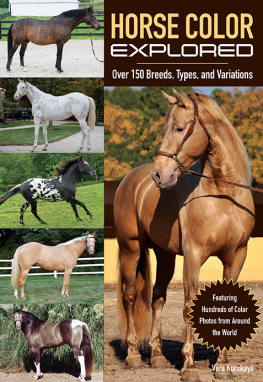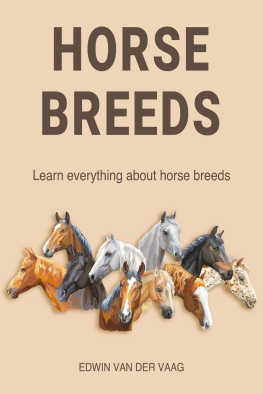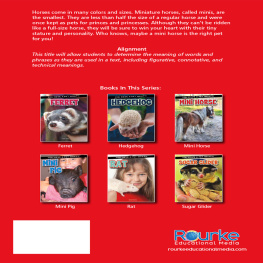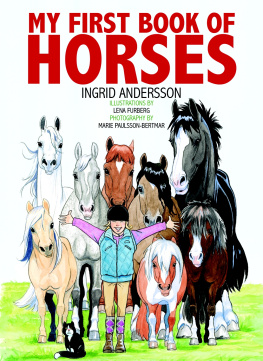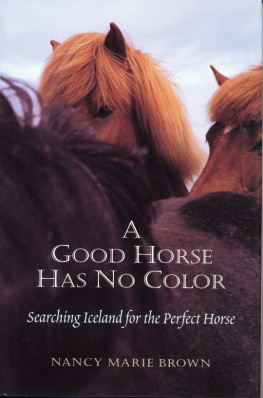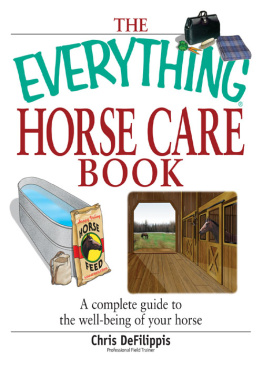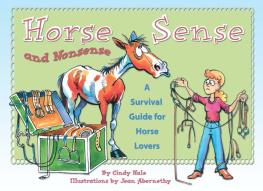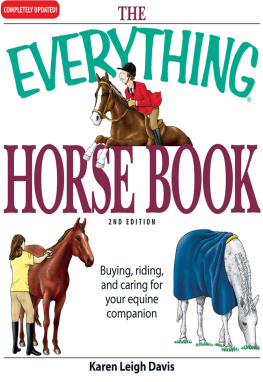HORSE
COLOR
EXPLORED
Over 150 Breeds,
Types, and Variations
Vera Kurskaya
TRANSLATED BY
DR. MICHAL PROCHAZKA
First published in 2017 by
Trafalgar Square Books
North Pomfret, Vermont 05053
Copyright 2017 Vera Kurskaya
All rights reserved. No part of this book may be reproduced, by any means, without written permission of the publisher, except by a reviewer quoting brief excerpts for a review in a magazine, newspaper, or website.
Disclaimer of Liability
The author and publisher shall have neither liability nor responsibility to any person or entity with respect to any loss or damage caused or alleged to be caused directly or indirectly by the information contained in this book. While the book is as accurate as the author can make it, there may be errors, omissions, and inaccuracies.
Trafalgar Square Books encourages the use of approved safety helmets in all equestrian sports and activities.
Library of Congress Cataloging-in-Publication Data
Names: Kurskaya: Vera, author.
Title: Horse color explored: over 150 breeds, types, and variations / Vera Kurskaya; translated by Michal Prochazka, PhD.
Other titles: 880-01 . English
Description: North Pomfret, Vermont: Trafalgar Square Books, 2016. | Includes index.
Identifiers: LCCN 2016024680 (print) | LCCN 2016040655 (ebook) ISBN 9781570767319 (pb) | ISBN 9781570768101 (kindle) | ISBN 9781570768118 (epub)
Subjects: LCSH: HorsesColor. | HorsesGenetics.
Classification: LCC SF279.K87 2016 (print) | LCC SF279 (ebook) | DDC 636.1/0821dc23
LC record available at https://lccn.loc.gov/2016024680
COVER PHOTOS:
Front (left side, from top to bottom): Natal Clasi, a Brazilian Warmblood owned by Vivian Hill, Stonybrook Far, photo by Vivan Hill; Painted Patchen, a Thoroughbred bred by Patchen Wilkes Farm LLC, photo by KS Veitch Photography; Twilight Reemarkable, owned by Lisa Estridge, Palisades Appaloosas (www.palisadesapps.com), photo by Lisa Estridge; Zippos Millenium Bug, an American Quarter Horse owned by Heidi Trimber, photo courtesy of Carolyn Shepard; California Champagne, an American Paint Horse owned by Michele Jorgenson, photo by Carolyn Shepard
Front (main): Photo courtesy of Yeguada Paco Marti
Back: Left top photo of PKR Primavera Brio, a Morgan owned by John Hutcheson, Gab Creek Farm (www.gabcreekfarm.com), photo by Laura Behning (www.brookridgemorgans.com); middle top photo by Olga Yeremeeva; right top photo of Aktepel, an Akhal-Teke owned by Amrita Eldine Ibold, Sweet Water Farm Akhal-Teke (www.akhalteke.cc), photo by Amrita Eldine Ibold; author photo by Polina Lurye
Cover design by RM Didier
Book design by Brian P. Graphic Arts | www.brianpgraphics.com
Typefaces: Body set in ITC Franklin Gothic and ITC Slimbach
Printed in China
10 9 8 7 6 5 4 3 2 1
Contents
Preface
I think my story is an unusual one. I am a Russian horsewoman, and I study horse colors, their variations, and the genetic mechanisms controlling them. I have always been interested in colors in a general sense, paying attention to those around me all the time. Surely, this linked to my love of horses and led to an interest in horse colors. But for a very long time my curiosity remained unsatisfied because of the lack of literature on the subject in my country.
When I was a teenager, I also dreamed of being a professional show jumper. But at the age of 20 an injury meant I couldnt continue riding horseback any more. What could I do to keep horses in my life? I started reading every equine book and magazine I was able to get my hands on, and eventually, I came across an article about horse color genetics. I learned of a mysterious champagne color that existed but was not, however, well described. I was intrigued. I did my best to find information about the color, discovering there was a group of colors controlled by the Champagne gene. As I searched for the details, I was drawn deeper and deeper into the world of horse colorand I am absolutely sure it is an entire world! I started a blog explaining horse colors to others who felt an interest in the subject. People began to ask for my help in identifying colors and in predicting foals colors. Time passed, and some years after I first started my blog, I felt I had accumulated enough information to do what hadnt yet been done: a specialty horse color book in Russian. And I felt the need to write it myself.
The first edition of my book was published in 2011, and it was so popular all the copies were sold in two months. A year later I published a revised versionand now you have an English edition in your hands.
More than 10 years have passed since the moment I started to study horse colors, and many things have changed for me. My published book has led to clinics at equine exhibitions, and what was a hobby at first grew into scientific work. I started my own research concerning the rare Silver gene in horse breeds originating in Russia. By 2015 I had discovered the Silver gene mutation and silver colors in Soviet Heavy Draft and Byelorussian Harness breeds. I can say that because of). Such discoveries are very important for the rare or threatened horse breeds, as they can increase interest and thus the breeds chance of survival.
My research continues today. As of 2016, I became a post-graduate student at the Russian State Agricultural University named after K.A. Timiryazev, the oldest and the best agrarian university in my country. My thesis, of course, is devoted to my favorite subjecthorse color identification.
I am so glad that my book is now published in the English language. When I first began studying horse color, most of my sources were in English because of lack of information in Russian. That is why my first aim was to tell something new to my native horsemen. Now I hope to say something new to English-speaking horsepeople around the world.
Writing and publishing a book is never an easy matter, and I am grateful to all the people who helped me with this process. I thank my husband for his patience, faith, and support. Thank you to Yevgeniy Matuzov for his interest in horse color genetics and generous support of my Silver gene research, and to Tatyana Zubkova for her Dun gene research, which is really important for the conservation of Russian Don and Budyonny breeds.
I especially thank Dr. Michal Prochazka, who respected my book enough to be so kind as to translate it into English. The English edition you are holding in your hands now would have been impossible without his participation.
I also thank Barbara Kostelnik for the effort she puts into her website devoted to rare horse color dilutions and for her kind help with the DNA test for the Iberian stallion Oro Mafiozo (see ), Lee Patton and Holly Zech for their contribution to Oro Mafiozos test, and Yelena Volkova for her questions, which were always very difficult to answer, but I did my best, and they made me go out of my comfort zone and move far forward.
I thank all the owners, breeders, breed associations, and photographers from around the world who helped provide the photos for this book, and of course, I thank Trafalgar Square Books for making my book available for English-speaking horse people.
Vera Kurskaya
CHAPTER 1:
Introduction to
Horse Color
What Is Horse Color?
T o begin, it is necessary to offer my own definition of horse color. A horses color is genetically determined as the sum of color characteristics of the entire integument (natural outer covering of the animal), including hair, skin, hooves, and eyes.

